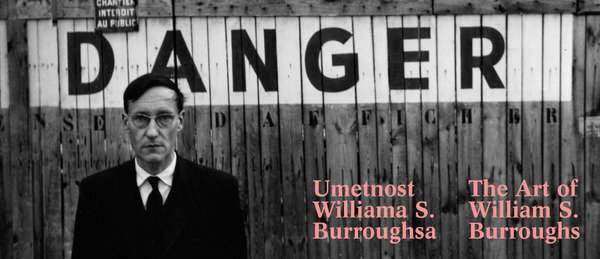Cut-ups, Cut-ins, Cut-outs
dal 18/2/2013 al 6/4/2013
Segnalato da
18/2/2013
Cut-ups, Cut-ins, Cut-outs
International Centre of Graphic Arts MGLC, Ljubljana
The Art of William S. Burroughs. From audio cut-ups, visual collages and abstract paintings depicted with a shotgun, to rare books, films, photographs and ephemeral material. Many works have so far been rarely exhibited.

“Life is made up of little fragments,” William S. Burroughs
The Exhibition Cut-ups, Cut-ins, Cut-outs: The Art of William S. Burroughs comes to the International Centre of Graphic Arts (MGLC) in Ljubljana from the Kunsthalle Wien in Vienna, where it enjoyed great success as a highly attractive show, due to its rich mix of media, by which the visionary power of the artist’s oeuvre is superbly presented. In terms of art, it is relevant in its analysis of his impact on contemporary art. The exhibition is the first presentation of the visual oeuvre of William S. Burroughs in Slovenia.
Brion Gysin, William S. Burroughs, Danger, Paris, 1959, Barry Miles Archive
Cut-ups, Cut-ins, Cut-outs: The Art of William S. Burroughs is a presentation of the exciting and experimental oeuvre of American writer and artist, William Seward Burroughs (1914–1997). It encompasses a thematic selection of his works created in a variety of mediums: from audio cut-ups, visual collages and abstract paintings depicted with a shotgun, to rare books, films, photographs and ephemeral material. Many works have so far been rarely exhibited. The artwork of William S. Burroughs is hard to define, since the artist offers many ways of reading and understanding his extensive creative oeuvre. The exhibition places a special focus on the collage and cut-up techniques, which form an important and influential part of Burroughs’ artistic language, as well as his creative legacy.
Since Burroughs’ cut-ups can be seen at MGLC in numerous and very diverse mediums all in one place, the exhibition highlights the merging of artistic fields, so typical for his body of work. He had an influence on a wide range of pop culture, art, music and digital sampling with this method. The cut-up method was a continuation of the ideas of Tristan Tzara, which he described in How to Make a Dadaist Poem (Pour faire un poème dadaïste) (1920). Burroughs acquainted Brion Gysin with this method, who accidentally discovered or re-invented it in Paris in October 1959, when cutting out passe-partouts for watercolours with a Stanley knife.
Burroughs influenced the work of several generations of artists with his innovations, and generally made an impact on the thinking of several generations with his viewpoints. Burroughs’ early experiments in collage, with all the possibilities that they opened up, exerted great influence on a number of musicians in the way they spliced magnetic tape and formed texts, like for instance The Beatles, Frank Zappa, Lou Reed, David Bowie, Brian Eno, Patti Smith, Laurie Anderson and Sonic Youth. But as a free-thinker, Burroughs was particularly influential during the period when he spent time with the American beatniks, including Jack Kerouac and Allen Ginsberg. His idea of the electronic revolution was adopted by the hippies as well as the punks, and later by the cybernists.
* * *
On the occasion of the exhibition, a reissue of the exhibition catalogue Cut-ups, Cut-ins, Cut-outs: The Art of William S. Burroughs (published by the Kunsthalle Wien, Verlag für Moderne Kunst, Kunsthalle Wien editors, Colin Fallows, Synne Genzmer) will be released. The catalogue features the latest research on the artist’s work as well as interviews with him. It also includes black-and-white as well as colour reproductions of his most significant works. The catalogue is in the German and English language, contains 176 pages, and costs 25 EUR.
International Centre of Graphic Arts MGLC
Grad Tivoli, Pod turnom 3 - Ljubljana



